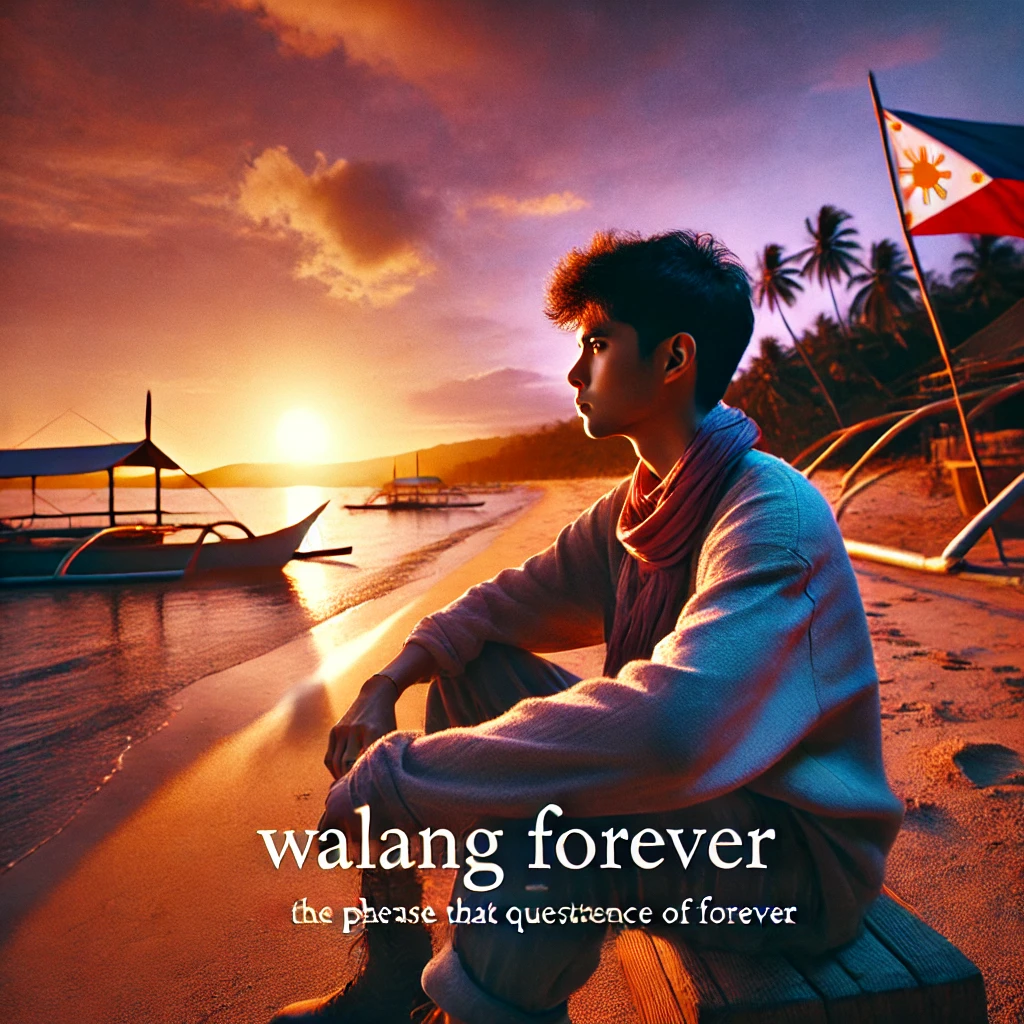Picture this: you’re scrolling through your social media feed, minding your own business, when suddenly you’re hit with a barrage of posts all screaming the same thing – “Walang Forever!” (There’s no forever!). If you’ve been anywhere near Filipino pop culture in the last decade, chances are you’ve encountered this phrase more times than you’ve had hot meals. But what’s the deal with this seemingly pessimistic declaration? Is it just another fleeting internet trend, or does it hold a deeper meaning that resonates with the collective psyche of a generation? Buckle up, folks, because we’re about to dive deep into the world of “Walang Forever” and explore why this simple phrase has captured the hearts (or should we say, broken the hearts) of millions.
The Origins: From Silver Screen to Meme Dream
The Cinematic Spark
Our journey begins in the glitzy world of Filipino cinema. The year was 2014, and a little romantic comedy called “That Thing Called Tadhana” hit the screens. Little did the filmmakers know that they were about to unleash a cultural phenomenon. The film’s protagonist, played by Angelica Panganiban, uttered the now-infamous line: “Walang forever!” in a moment of drunken despair over a failed relationship. It was meant to be a throwaway line, a momentary lapse into cynicism. But oh boy, did it stick!
Meme-ification and Viral Spread
From that single cinematic moment, “Walang Forever” took on a life of its own. It spread like wildfire across social media platforms, morphing into countless memes, hashtags, and even merchandise. Suddenly, everyone and their grandmother was using the phrase to comment on everything from celebrity breakups to political promises. It became the go-to response for any situation that seemed too good to be true or any relationship that hit a rocky patch.
The Psychology Behind the Phrase: Why Did It Stick?
Resonance with Millennials and Gen Z
So, why did “Walang Forever” strike such a chord with the younger generations? Let’s break it down:
- Disillusionment with traditional narratives: Millennials and Gen Z have grown up in a world where happily-ever-afters seem increasingly rare. From witnessing high divorce rates to experiencing economic uncertainties, the idea of “forever” in any context feels like a fairy tale.
- The age of instant gratification: In a world of swipe-right dating and 24/7 connectivity, the concept of long-lasting commitment seems almost quaint. “Walang Forever” encapsulates the fast-paced, ever-changing nature of modern relationships.
- A shield against disappointment: By embracing the idea that nothing lasts forever, young people arm themselves against the pain of loss or failure. It’s a preemptive strike against heartbreak, if you will.
- Humor as a coping mechanism: Let’s face it, sometimes life’s tough realities are easier to swallow when they’re served with a side of humor. “Walang Forever” allows people to acknowledge the transient nature of things while still keeping things light.
The Cultural Impact: More Than Just a Catchphrase
Influence on Pop Culture
“Walang Forever” didn’t just stop at being a viral phrase; it seeped into every nook and cranny of Filipino pop culture. Here’s a quick rundown of its impact:
| Medium | Examples of “Walang Forever” Influence |
|---|---|
| Movies | Multiple films with “Forever” in the title, often playing on the concept |
| Music | Songs exploring the theme of impermanence in love |
| Literature | Books and poems questioning the idea of eternal love |
| Art | Visual artworks and installations inspired by the phrase |
| Fashion | T-shirts, accessories, and even tattoos featuring the slogan |
Societal Reflection
Beyond entertainment, “Walang Forever” became a mirror reflecting societal attitudes towards love, commitment, and life in general. It sparked discussions about the nature of relationships in the modern age and whether long-term commitments are still viable or desirable. Sociologists and psychologists found themselves analyzing the phrase’s popularity as a indicator of changing social norms and values.
The Backlash: Forever Fights Back
The Rise of #MayForever
As with any cultural phenomenon, “Walang Forever” eventually faced its own opposition. Enter the #MayForever (There is Forever) movement. This counter-trend sought to reclaim the idea of lasting love and commitment. Suddenly, social media was a battleground between the cynics and the romantics, each armed with their own arsenal of memes and heartfelt posts.
The Great Debate
The clash between “Walang Forever” and “May Forever” sparked some interesting debates:
- Is eternal love possible in the age of disposable relationships?
- Are we too quick to give up on commitments when faced with challenges?
- Is the concept of “forever” harmful, setting unrealistic expectations?
- Can embracing impermanence lead to more fulfilling relationships?
These discussions moved beyond social media, finding their way into academic circles, relationship counseling sessions, and even philosophical debates. Who knew a simple movie line could lead to such profound soul-searching?
The Science of Forever: What Does Research Say?
Relationship Longevity Studies
While “Walang Forever” might make for catchy social media posts, what does science have to say about the longevity of relationships? Let’s look at some research:
| Study | Findings |
|---|---|
| Gottman Institute (2018) | Identified specific behaviors that predict long-lasting relationships, suggesting that “forever” is possible with effort |
| Journal of Marriage and Family (2020) | Found that couples who view their relationship as a lifelong commitment tend to have higher satisfaction levels |
| Psychology Today survey (2019) | Revealed that 64% of millennials believe in soulmates, despite the popularity of phrases like “Walang Forever” |
The Paradox of Choice
Interestingly, some psychologists argue that the “Walang Forever” mentality might actually be a response to the overwhelming number of choices available in modern dating. With dating apps offering seemingly endless options, the idea of settling down with one person “forever” can feel daunting. It’s like being in a candy store and being told you can only have one piece for the rest of your life. No wonder some people are shouting “Walang Forever” from the rooftops!
“Walang Forever” in the Digital Age: Swipe Left on Permanence
The Impact of Social Media and Dating Apps
In the era of Instagram-perfect relationships and Tinder swipes, the concept of “forever” seems almost quaint. Let’s break down how digital culture has contributed to the “Walang Forever” mindset:
- The highlight reel effect: Social media shows us the best moments of everyone’s relationships, creating unrealistic expectations. When real-life doesn’t match up, it’s easy to think, “Well, I guess there’s no forever after all.”
- The paradox of choice: With dating apps offering a seemingly endless pool of potential partners, the grass always seems greener on the other side. Why settle for “forever” when there might be someone better just a swipe away?
- Instant gratification culture: In a world where we can get anything with a click, the idea of working on a relationship for the long haul can seem, well, boring.
- The public nature of breakups: Remember when a breakup was a private affair? Now, with relationship status updates and public callouts, every split becomes a spectacle, reinforcing the “Walang Forever” narrative.
Embracing Impermanence: The Upside of “Walang Forever”
Finding Freedom in Flux
Now, before you go crying into your pillow about the death of romance, let’s look at the silver lining of the “Walang Forever” cloud. There’s actually some wisdom in embracing impermanence:
- Living in the present: When we let go of the pressure for things to last “forever,” we can fully appreciate what we have right now.
- Personal growth: Accepting that change is inevitable allows us to grow and evolve, rather than clinging to outdated versions of ourselves or our relationships.
- Resilience building: Understanding that nothing lasts forever can actually make us more resilient when faced with loss or change.
- Cherishing moments: When we stop taking “forever” for granted, we learn to cherish each moment and each connection, no matter how brief.
The Global Perspective: “Walang Forever” Around the World
Universal Themes in Different Languages
While “Walang Forever” might be a distinctly Filipino phrase, the sentiment behind it resonates globally. Let’s take a whirlwind tour of similar concepts around the world:
| Country/Language | Equivalent Phrase | Literal Translation |
|---|---|---|
| French | “Rien ne dure” | “Nothing lasts” |
| Japanese | “無常” (Mujō) | “Impermanence” |
| German | “Nichts ist für immer” | “Nothing is forever” |
| Spanish | “Nada es para siempre” | “Nothing is forever” |
| Russian | “Ничто не вечно” (Nichto ne vechno) | “Nothing is eternal” |
It seems that no matter where you go, people are grappling with the concept of impermanence. It’s like a global support group for the existentially challenged!
The Future of Forever: Evolving Perspectives
Redefining Commitment in the Modern Age
As we hurtle towards an uncertain future, how will our concept of “forever” evolve? Here are some predictions:
- Flexible forever: Instead of a one-size-fits-all approach to commitment, we might see more flexible arrangements that allow for personal growth and change.
- Serial monogamy: The idea of having multiple “forevers” throughout one’s life might become more accepted and celebrated.
- Technology-assisted longevity: With advancements in relationship apps and AI, we might have digital tools to help us navigate long-term commitments more successfully.
- Mindfulness in relationships: As mental health awareness grows, we might see a shift towards more mindful, present-focused relationships rather than future-oriented “forever” thinking.
Forever Is What You Make It
As we wrap up our deep dive into the world of “Walang Forever,” what have we learned? Well, for starters, that a simple movie line can spark a cultural revolution (note to self: be careful what you say on camera). But more importantly, we’ve seen how this phrase reflects broader societal shifts in how we view love, commitment, and the very nature of permanence.
Whether you’re Team Walang Forever or firmly in the May Forever camp, the truth is, forever is what you make of it. Maybe it’s not about finding a love that lasts forever, but about creating moments so beautiful you wish they could. Or perhaps it’s about redefining what “forever” means to you – be it a lifetime, a season, or just a really awesome Tuesday afternoon.
So the next time someone hits you with a “Walang Forever,” you can smile knowingly and say, “Maybe not, but there’s definitely a forever in this moment.” And then quickly change the subject before they realize you’ve gone all philosophical on them.
Remember, in a world where nothing lasts forever, the ability to laugh, love, and keep swiping (respectfully, of course) might just be the closest thing to eternal we’ve got. Now, if you’ll excuse me, I’m off to trademark “Walang Forever, But Maybe Mamaya” (There’s no forever, but maybe later). Wish me luck!
Disclaimer: This blog post is based on cultural observations and available data up to 2022. The author acknowledges that perspectives on relationships and “forever” can vary widely based on individual experiences and cultural backgrounds. If you spot any inaccuracies or have updated information, please let us know so we can keep this discussion as eternal as… well, you know.




